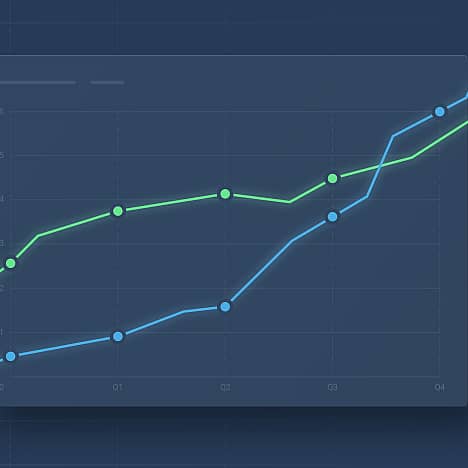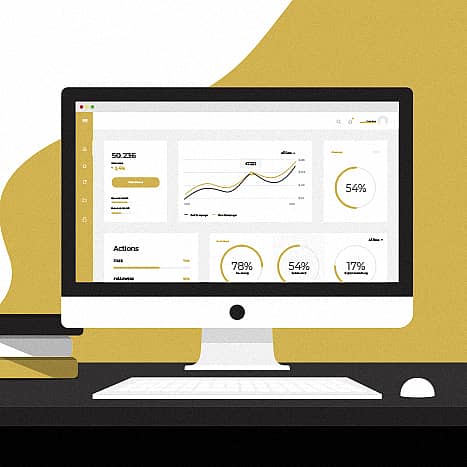Setting a few strong goals and key performance indicators (KPIs) helps you evaluate the success of your website and marketing initiatives and determine if you need to make any adjustments. But it’s easy to run into pitfalls like overcomplicating your goals and KPIs or not setting them up ahead of time. Here are a few tips for setting goals and KPIs to better measure your website and marketing performance.
Figure out what defines “success” for your project, business objectives, or situation.
When defining goals and key performance indicators, the data you track will differ by the situation. Maybe you have a specific goal or number in mind – for example, a better clickthrough rate or lower cost per click for your ads. If you don’t, try working backward from your revenue or gross profit margin goals to determine certain KPIs along the sales funnel.
This can be as simple as asking how much you’re willing to pay for a lead. Let’s say you’re looking to run ads through Google Search, and you’re willing to pay $10 per lead. You can work backward to calculate the average click-through rate and cost per click, which will help you determine the budget. Measuring against these KPIs shows if you’re performing successfully or if you need to adjust your goals.
Define a few strong, relevant, trackable goals and KPIs.
Here are some examples:
- Click-Through Rate (CTR): how many people clicked on your ad or a link in your email?
If your goal is to increase the effectiveness and visibility of your ads – to reach the right people at the right time – improving your CTR is a good KPI. A high CTR indicates your ad is answering your potential customers’ questions or piquing their interest. A low CTR would indicate people are passing over your ad for something that better answers their questions. - Cost Per Click (CPC): for paid advertising, how much did you pay for a customer’s click on your ad?
A low CPC is generally better. If your goal is improving ad quality to reach more people for less money, or staying under budget for an ad campaign, your CPC says a lot. For example, it can tell you you’re on track to stay under budget, or that you need to adjust your spending. Or, it can indicate that your ads are competitive and relevant, or that you need to test and improve them more. - Conversion Rate: out of all the people who arrived on a page, how many completed an action?
Actions are things like completing email signup forms or making a purchase. A high conversion rate is best because it indicates successful ads that drive conversion. Conversion rate can be impacted by things like the calls to action on a page or the length of a form a potential customer might need to fill out. It can also point to whether your ads are attracting the right audience. Testing can help optimize conversion rate performance.
These goals create a high-level funnel for your customer’s journey: from acquisition through conversion.
Measure outcomes and evaluate areas for potential improvement.
Here are a few tools to help you:
- Google Analytics helps you set goals and track events on your website. It’s important to set up goals and events ahead of time to properly benchmark and optimize your performance since GA data isn’t retroactive. GA is a useful tool to measure the success of your goals or to test your ads and calls to action. For example, if your ads are created to drive inquiry submissions, you can track the conversion rate for submissions.
- Google Data Studio is a great visualization tool to see how KPIs are progressing. It’s easy to set up simple one-page summaries or more in-depth reports to see and compare progress, or to identify trends and areas for improvement.
- Google AdWords provides some great tools to review CPC, CTR, projected versus actual budget, and other KPIs for ads. Cost on AdWords is impacted by your quality score, which is determined by how relevant your ads are if people have a good experience on your landing page, and the expected CTR. If you have a low quality score, you pay more. If you have a high quality score, you pay less. Thus, the better your ads on AdWords, the lower the CPC.
- Excel is great for creating custom reports, such as combining data sets to derive more insights. For example, if you combine sales data with ad data, you can determine the return on investment (ROI) on the ads, which is used to evaluate or compare how efficient your investments are – how successful your initiatives are, and where you could make improvements.
All in all, setting goals and KPIs is a great way to measure success and identify what you can do better. Setting strong, simple goals and tracking and measuring them correctly can determine how you’re performing and whether you need an adjustment. By setting good goals and KPIs you can gain helpful insights without draining your time or resources.



